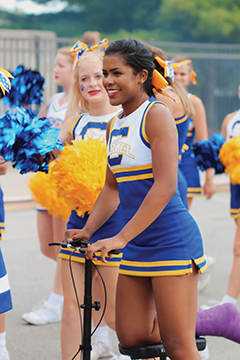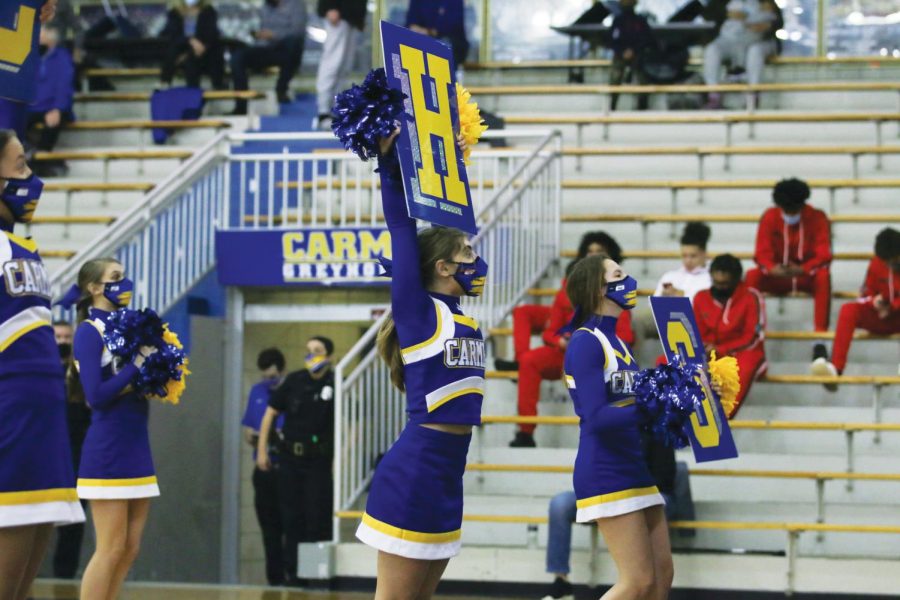For Sharon Zhou, varsity gold cheerleader and sophomore, falling from the extended arms of a couple of teammates is nothing new.
“For me, flying wasn’t physically-hard (but) it was more mentally hard because when the stunt falls, everyone looks at you because you’re the one that they’re looking at in the air,” Zhou said. “They just automatically assume it’s your fault even though you don’t really have control of what’s under you; all you can do is just pray that it stays up.”
Zhou, who used to do competitive cheerleading as a flyer at Ice All-Stars, a competition-based cheerleading team in Indianapolis, is now a “secondary base” (a cheerleader who helps lift the flyer and supports the flyer’s left foot) for fall cheerleading and a “main base” (a cheerleader who helps lift the flyer and supports the flyer’s right foot) for winter cheerleading. Zhou said she decided to be a base instead of a flyer because it is safer since everyone is relatively the same size in fall cheerleading and winter cheerleading at this school, as compared to her previous experience at Ice All-Stars.
“When I used to fly, I got dropped a lot and I got a lot of concussions from it, so I was just scared of getting hurt,” Zhou said. “I wasn’t scared of doing the actual stunts; I was scared of getting hurt and not being able to participate in the season.”
Zhou is not alone with her concerns. According to a 2017 Center for Injury Research and Policy study of cheerleaders age 5 to 18, falls resulted in 29.4% of injuries and were the most common cause of injury and cause of hospitalization.
Athletic trainer Chad Bergman said he has seen numerous cheerleading injuries.
“I have seen ruptured Achilles tendons (strong band of fiber tissue that connects the calf muscle to the bone of the heel), lacerations (profound tears in the flesh or the skin) and concussions to name a few,” Bergman said via email.
In spite of this, there have been decreases in injuries due to new safety precautions. According to a 2018-2019 National Federation of State High School Associations (NFHS) study, out of the 20 high school sports that were studied, cheerleading was ranked as having the 17th lowest overall injury rate.
To help further these efforts, Brooke Kibler, head coach of fall cheerleading and a co-head coach of winter cheerleading, said she has the cheerleaders complete a warm-up based upon a level system. In this system, the cheerleaders, no matter what team they are on, begin with basic stunts and progress to harder stunt levels.
“We start with the easy stuff first and (us coaches) make sure that, before we begin, everybody knows where the essential emergency stuff is. We make sure they know where the trainers are and we make sure we know who the CPR-certified and first-aid-certified people are and basically we build from the bottom up,” Kibler said. “We start at the belly area, and then we work up to the shoulders and then we’ll work up to (having the arms of the cheerleaders holding the flyer) extended.”
Zhou said this system of using levels is beneficial in limiting injury risk during stunts.
“A major part of it is (that) we first start warm-up at the beginning of practice. (The coaches) don’t want to just throw all these hard stunts at us when we’re obviously not ready,” Zhou said. “While doing those stunt warmups, we train our body and we use our technique so that we can prepare ourselves for the harder stunts that we have to do such as ‘full-ups’ (the flyer does a 360-degree turn in the air), ‘one-and-a-half ups’ (the flyer stays in a straight position while doing a 360-degree flip and a 540-degree twist), ‘switch-ups’ (the flyer switches the foot that the flyer is standing on while the bases are extending their arms and the flyer lands at the top of the stunt on the foot which the flyer switched too).”
Samantha “Sam” Jackson, junior varsity cheerleader for fall and winter cheerleading and junior, also said this system is helpful for limiting risk.

“I think that people who haven’t done the more advanced stunts or maybe don’t have as much experience doing the simple stunts (can) go into the harder stunts with technique that isn’t as good,” Jackson said. “So, when you start off getting all the basics down and setting the foundation, it makes everything else safer because you have the right technique.”
Jackson also said she is a “backspot,” which requires a lot of responsibility in communicating the steps to take to her teammates in order to prevent any injuries.
“I see over the stunt and so if something were to go wrong, then I can tell people to let go and catch our flyer,” Jackson said. “I have to always pay attention to everything going on because if I see that one of the bases is struggling to hold the foot, then I know that the flyer might fall soon. So, I have more responsibility if the flyer falls (because) I have to make sure that (the bases are) ready to catch her.”
Kibler said she agreed and said the use of such safety precautions allows for a more successful season where cheerleaders can spend more time hyping up the fans and motivating the team they are cheering for.
“If you hear the cheerleaders saying, ‘Yell, Go Blue!,’ please yell, ‘Go Blue!’ (because) it’s much easier to cheer when the crowd is yelling with you,” Kibler said. “That’s all we’re trying to do; (we’re trying to) get the crowd to yell and be louder and more engaged and more involved, so that way, the football team can hear that and it can cheer them on. We’re just trying to get them towards a win.”
For more information on cheerleading dangers visit: https://www.usacheer.org/new-cheerleading-safety-data
For more on upcoming cheerleading events visit: https: //gocarmelgreyhounds.com/teams/2953327/sideline-cheer/varsity-blue





























![Keep the New Gloves: Fighter Safety Is Non-Negotiable [opinion]](https://hilite.org/wp-content/uploads/2024/12/ufcglovescolumncover-1200x471.png)
















































![Review: “We Live in Time” leaves you wanting more [MUSE]](https://hilite.org/wp-content/uploads/2024/12/IMG_6358.jpg)
![Review: The premise of "Culinary Class Wars" is refreshingly unique and deserving of more attention [MUSE]](https://hilite.org/wp-content/uploads/2024/12/MUSE-class-wars-cover-2.png)
![Introducing: "The Muses Who Stole Christmas," a collection of reviews for you to follow through winter [MUSE]](https://hilite.org/wp-content/uploads/2024/12/winter-muse-4.gif)
![Review: "Meet Me Next Christmas" is a cheesy and predictable watch, but it was worth every minute [MUSE]](https://hilite.org/wp-content/uploads/2024/11/AAAAQVfRG2gwEuLhXTGm3856HuX2MTNs31Ok7fGgIVCoZbyeugVs1F4DZs-DgP0XadTDrnXHlbQo4DerjRXand9H1JKPM06cENmLl2RsINud2DMqIHzpXFS2n4zOkL3dr5m5i0nIVb3Cu3ataT_W2zGeDAJNd_E-1200x884.jpg)
![Review: "Gilmore Girls", the perfect fall show [MUSE]](https://hilite.org/wp-content/uploads/2024/11/gilmore-girls.png)
![Review in Print: Maripaz Villar brings a delightfully unique style to the world of WEBTOON [MUSE]](https://hilite.org/wp-content/uploads/2023/12/maripazcover-1200x960.jpg)
![Review: “The Sword of Kaigen” is a masterpiece [MUSE]](https://hilite.org/wp-content/uploads/2023/11/Screenshot-2023-11-26-201051.png)
![Review: Gateron Oil Kings, great linear switches, okay price [MUSE]](https://hilite.org/wp-content/uploads/2023/11/Screenshot-2023-11-26-200553.png)
![Review: “A Haunting in Venice” is a significant improvement from other Agatha Christie adaptations [MUSE]](https://hilite.org/wp-content/uploads/2023/11/e7ee2938a6d422669771bce6d8088521.jpg)
![Review: A Thanksgiving story from elementary school, still just as interesting [MUSE]](https://hilite.org/wp-content/uploads/2023/11/Screenshot-2023-11-26-195514-987x1200.png)
![Review: "When I Fly Towards You", cute, uplifting youth drama [MUSE]](https://hilite.org/wp-content/uploads/2023/09/When-I-Fly-Towards-You-Chinese-drama.png)
![Postcards from Muse: Hawaii Travel Diary [MUSE]](https://hilite.org/wp-content/uploads/2023/09/My-project-1-1200x1200.jpg)
![Review: "Ladybug & Cat Noir: The Movie," departure from original show [MUSE]](https://hilite.org/wp-content/uploads/2023/09/Ladybug__Cat_Noir_-_The_Movie_poster.jpg)
![Review in Print: "Hidden Love" is the cute, uplifting drama everyone needs [MUSE]](https://hilite.org/wp-content/uploads/2023/09/hiddenlovecover-e1693597208225-1030x1200.png)
![Review in Print: "Heartstopper" is the heartwarming queer romance we all need [MUSE]](https://hilite.org/wp-content/uploads/2023/08/museheartstoppercover-1200x654.png)




